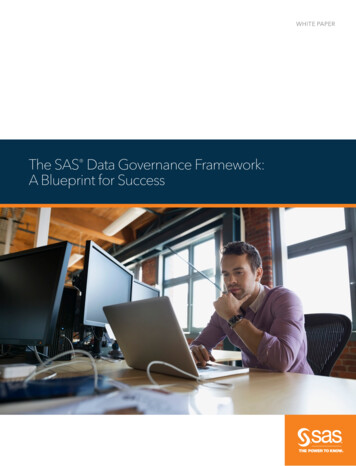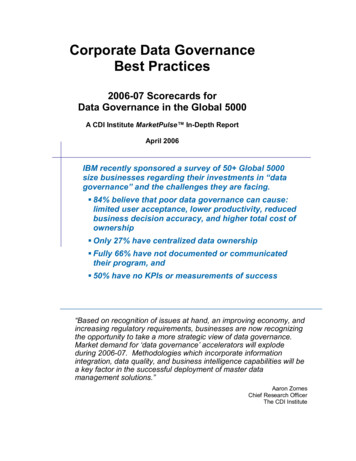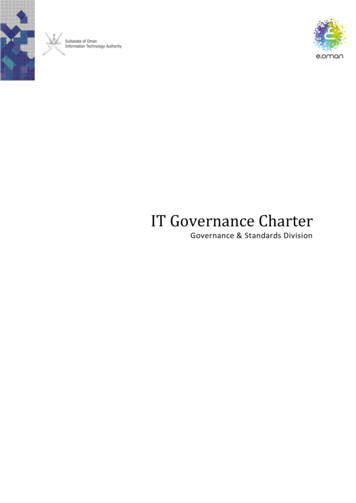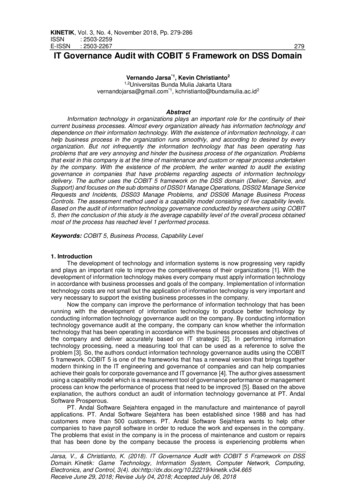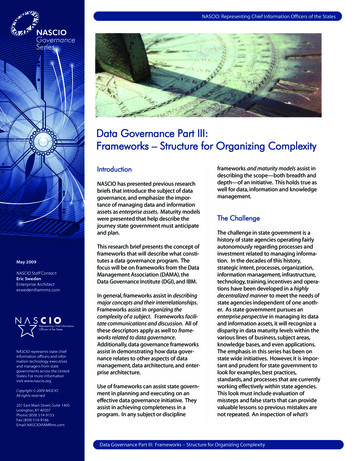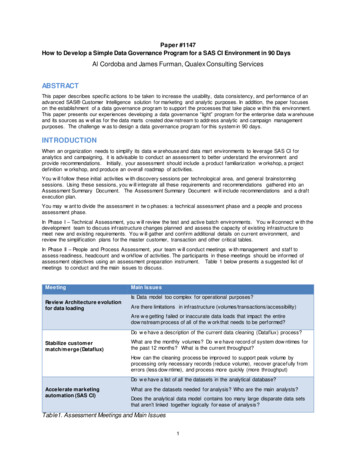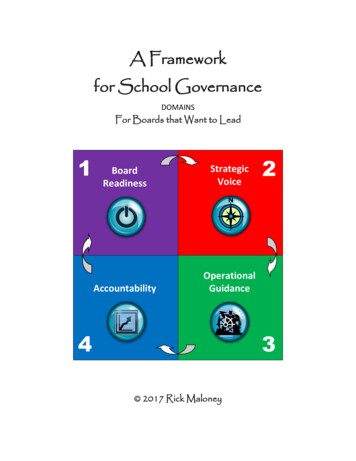
Transcription
A Frameworkfor School GovernanceDOMAINSFor Boards that Want to rationalGuidance234 2017 Rick Maloney
A Framework for School Governance“Any fool can know. The point is to understand.”― Albert EinsteinFrom the day we decide to run for the school board, we are flooded with advice from wellmeaning community members who “know” what is needed to fix the school system. Thatknowledge is often based on the fact that the advisors themselves “went to school” so theymust have something of value to offer about how schools should be run. As authenticcommunity input such advice deserves to be heard. Yet the kind of advice offered in the cornergrocery store, over the backyard fence, during PTA meetings, or at our kid’s sporting eventsrepresents for many the sum total of what we need to know about the board’s responsibility.Responsible governance demands that we know more.Surprisingly, even after joining the board most of us don’t get the kind of orientation we needor hope to receive, and our questions about why the board does the things it does are met with“That’s the way we do things around here.” So we wing it, perhaps taking in boardsmanshipsessions at the next conference. But boardsmanship alone (what a board member needs toknow and do) is just part of the story. What does a board need to know and do, and why?“Physician, heal thyself.”― ProverbAll school boards think about improving schools, but few think about starting with the boarditself. This document introduces a framework of ideas for school boards willing to explore theirown role, and developing their collective competence in the areas of governance,boardsmanship, and management. If they decide as a board to do so, they can begin toimprove their capacity by assessing current performance (or non-performance, in areas theymay be neglecting) and planning for future growth.The information that follows provides a brief description of school board responsibilities, in aformat that facilitates assessment and points the way toward specific areas of neededimprovement. At the broadest level a rubric consists of just four major responsibility areas, ordomains. From indicators of effectiveness in the far left column to evidence of distinguishedboards found in the far right column, each horizontal row of descriptors (values, attitudes,knowledge, skills, and actions) can be used to chart a path toward success in a particular boardresponsibility along a continuum from ineffective to basic to proficient to distinguished.Informed by time-honored examples of best practice and findings from research into boardeffectiveness that identify factors leading to district success, rubrics enable boards to identifyattributes associated with varying levels of board (and district) effectiveness. Once identified,those same board attributes can serve as motivators for continuous improvement, which inturn contributes to district and school improvement.2
4 Domains of Governance: Stabilized on a foundation of readiness,the board simultaneously juggles three essential responsibilitiesEffective boards speak for their community by giving strategic (long-term) as well as operational(day-to-day) guidance, then follow up by monitoring to assure success. They “trust, but verify”and thereby maintain a careful balance between micromanaging or over-supervising andabdicating the board’s lawful responsibilities to direct the work and assure its success.3. OperationalGuidance2. StrategicVoiceDirectthe WorkGuiding the work, ensuringthe community’s voice isincluded in the guidanceOrienting the compassand declaring theintended destinationDefineExpectationsMonitorProgress4. AccountabilityMonitoring performanceto judge success andadjust for the future91. BoardReadinessGetting ready as a board tokeep the three ‘balls’ in theair and in balance at all timesBePreparedEstablishing and giving voice to strategic direction over the long-term, guiding day-to-dayoperations, and delivering accountability to constituents – these three board responsibilitiesare all essential, but they are not sufficient. Preceding and underlying all other board activity isa primary responsibility of establishing and maintaining our capacity to perform the other threewhile keeping them in balance. This foundational responsibility of board readiness enables aboard to keep those other three ‘balls’ in the air at all times.If a board spends most of its time, as many boards do, directing staff activity, it risks becomingentangled in one area of responsibility while ignoring all others, leaving them to the staff in akind of unintended role reversal. Getting stuck on operations, then, can distract the board fromthinking and acting strategically, and assuring accountability. Readiness to perform the fullspectrum of board responsibilities is therefore the most critical of board tasks, but is often noteven “on the radar” for a board that isn’t even looking.The next two pages provide an abbreviated framework in rubric form to help assess and guidethe board in performing its four primary responsibilities. They are described along a continuumfrom ineffective (does harm) to basic (avoids harm) to proficient (does good) to distinguished(creates a system that sustains and increases its capacity to do good).3
Ineffective1. The boardensures it isready togovern.The board: Is self-serving or serves special interests Takes no responsibility for the district Never considers its purpose as a board Lacks a clear approach to governing Doesn’t believe all kids can learn at highlevels; uses poverty an excuse Has no system by which it operates Has no rationale or overall plan for whatit does in board meetings2. The boardexercisesstrategicvoice onbehalf of thecommunity.The board: Fails to connect with the community Acts/reacts in inconsistent, ad hoc ways Operates without evidence of a plan Does not seem to know what thecommunity thinks is important Doesn’t understand student learning Fails to speak out for community values Sets policy ‘rules’ that do not haveunderlying values3. The boardgivesoperationalguidance.The board: Micro-manages staff work Ignores policy when making decisions Directs activity without saying why Has no distinction between board/staff Doesn’t respect the chain of command Focuses on activity rather than results Operates without principles or rules inrunning its meetings Allows its members to spring frequentsurprises on staff and other members4. The board The board:accounts for Rarely checks to see if staff are complyingperformance.with policy, nor if results are achieved Does not hold supt accountable Fails to consider data in decision-making Never reviews its own performance, northat of its members Uses blame and shame rather thanformative feedback Fails to set criteria for success, nor tocollect data for use in judging success4BasicThe board: Claims responsibility for the district, buttends to let the supt carry the burden Rarely discusses the board’s purposeapart from that of the supt Adopts a primarily management role Puts full authority in the supt’s hands Does not know student learning efforts indetail, leaving it to the staff Maintains a system of management, yethas no discernible system for governingThe board: Engages community to inform, not listen Has goals, but doesn’t tie them together Approves strategic plan, but does not useit in board work Considers the supt responsible for vision Focuses on annual board goals to thedetriment of stable, long-term goals Doesn’t always communicate values inpolicy languageThe board: Sets policies to direct staff work, but payslittle attention to those policies Gives inconsistent guidance to supt/staff Focuses on directing staff work Ignores guiding its own board work Is primarily a ‘figure-head’ board Submits to ‘care and feeding’ by a boardsavvy supt Directs, but fails to lead Avoids surprising staff or one anotherThe board: Checks to see if staff are following policy Holds staff but not the supt accountable Lets supt control info flow to the board Lets staff decide what student learningdata mean Sometimes reviews its own performance Describes an intent to account for districtsuccess, but doesn’t take steps tomeasure results
ProficientDistinguishedThe board: Considers itself ultimately responsible for districtperformance, and to serve others Views its role as different from that of the supt Believes all students can learn at high levels Has adopted guidance for its own processes Takes a strategic approach to board work Expects staff to align with board’s governance role Establishes an approach to governing that forgesstrategic and operational guidance andaccountability into one coherent systemThe board: Seeks contact with community to learn from it Main interaction with the community is listening Writes a strategic plan with non-negotiable goalsfor achievement and instruction Refers to strategic plan in board decisions Puts priority on student learning over other goals Ensures its own goals and the supt’s goals align Reflects community values in its policy languageThe board, in addition to proficient indicators: Dedicates itself to a servant-leader role Adopts a growth mindset that values effort toovercome obstacles to learning Believes in the potential of all students, staff,and board members to grow Focuses meetings on strategic work vs.reviewing/approving staff activity Documents its systematic governing approach Actively pursues professional development tomaintain and enhance its governing approachThe board, in addition to proficient indicators: Nurtures an ongoing community connection tolearn its values and vision for students Ensures long-range goals for achievement andinstruction remain the district’s #1 priority Repeatedly reinforces vision of student success Can explain school improvement initiatives andits own role in their execution Aligns organizational and individual goals withthose of the strategic plan Incorporates values in policy/other board workThe board, in addition to proficient indicators: Sets clear expectations for staff work, boardwork, and individual board members as well Keeps focus of the district vision on achievementvs. administration of the district Spends most meeting time on student learningand policy vs. making management decisions Supports the chair’s role in guiding andmaintaining its documented governing process Empowers the supt and staff to get results whileworking within parameters set by the boardThe board, in addition to proficient indicators: Regularly reviews board work on a routineschedule in board meetings Holds supt accountable for district results, withpriority on student achievement Uses data (both and -) as a diagnostic tool Uses principle-guided parameters Evaluates supt, itself, and its board memberswith an eye toward growth in their capacity Responds to data, noting progress and adjustingcriteria for the next cycle of monitoringThe board: Adopts policy to guide the district and the board Consults policy when making decisions Aligns resource management with boardapproved goals Ensures staff know what the board expects forstaff work Sees to it that collegial cooperation is wellmanaged by the chair, who ensures the boardfollows its own guidanceThe board: Reviews results of board goals at least annually Monitors staff for compliance with expectations Evaluates supt against clear criteria Is not afraid of negative data Reviews its own performance and that of itsindividual members Compares data vs. criteria to evaluate thedistrict’s and the board’s performance Responds to data by declaring signs of progress5
Looking at the Framework in Greater DetailThe Framework for Governance can be explored in still greater detail, with two or three components perdomain of board responsibility. Altogether, the four domains can be divided into a total of ten componentsand thirty five elements.As an example, the domain of Board Readiness is composed of two components, mindset and approach.Aspects of mindset that reflect board readiness are the commitment to become a servant-leader, and agrowth mentality. A board employing the right mindset is significantly better prepared to govern effectively.Similarly, understanding and applying a strategic approach to governance helps us know what to focus on,how to do so, and most important of all, why it is important. As in the case of the broad four-domains rubric,each of ten components can be displayed along a continuum from ineffective to distinguished.1. Board Readinessa. Mindset(1) Commitment to Serve(2) Commitment to Lead(3) Belief in Growth(4) Work Ethicb. Approach(1) Systems Perspective(2) Systematic Process(3) Policy(4) Meetings4. Accountabilitya. District(1) District Performance Criteria(2) Monitoring District Performance(3) Responding to District Monitoringb. Board(1) Board Performance Criteria(2) Monitoring Board Performance(3) Responding to Board Monitoringc. Board Member(1) Board Member Performance Criteria(2) Monitoring Board Member Performance(3) Responding to Board Member Monitoring2. Strategic Voicea. Values(1) Transparency and Trust(2) Board-Community Connection(3) Policy as Internal Voice(4) Advocacy as External Voiceb. Vision(1) Goal-setting Process(2) Student Focus(3) Results Orientation(4) Time Perspective3. Operational Guidancea. Boardsmanship Guidance(1) Board Member Role(2) Setting Boardsmanship Protocol(3) Facilitating Boardsmanshipb. Governance Guidance(1) Board Role(2) Setting Governance Policy(3) Facilitating Governancec. Management Guidance(1) Superintendent Role(2) Employing the Superintendent(3) Setting Management Policy(4) Delegating and Providing SupportFor more information on this framework, see www.governance101.com.6
Fails to consider data in decision-making Never reviews its own performance, nor that of its members Uses blame and shame rather than formative feedback Fails to set criteria for success, nor to collect data for use in judging success Checks to see if staff are
